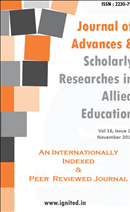A Brief Study on Wastewater Treatment and Reuse
Keywords:
Wastewater, Seawage, ReuseAbstract
With 80 nations and 40 percent of the world's population facing incessant water problems and multiplying water demand at regular intervals, the extracts referred to above merit action. Agriculture is the biggest source of reuse and sewage in residences is the equally biggest misplaced asset. Either waste or pee is contaminated with sewage. Sewage is generated through living arrangements, hospitals, offices, extensions and so on. Sewage includes residential, municipal or industrial liquid, usually arranged by a canal or sewer (sanitary or joined); local sewage includes a wide range of separate and suspended contamination, and is the main source of putrescible and pathogenssubstances that are organic (microorganisms that cause disease).
References
Abu Mad i, M., Braadbaart, O., Al-Sa’ed, R., &Alaerts, G. (2003). Willingness of farmers to pay for reclaimed wastewater in Jordan and Tunisia. Water Science and Technology: Water Supply, 3 (4),115-122
Achilleos, A., Kythreotou, N., &Fatta, D. (2005). Development of tools and guidelines for the promotion of the sustainable urban wastewater treatment and reuse in the agricultural production in the Mediterranean Countries. Technical Guidelines on Wastewater Utilization, European Commission, June 2005
Agyin-Birikorang, S., O’Connor, G.A., Jacobs, L.W., Makris, K.C., Brinton, S.R., 2007. Long-term phosphorus immobilization by a drinking water treatment residual. J. Environ. Qual. 36, 316–323.
Ahmad T, Ahmad K, Alam M, 2016. Sustainable management of water treatment sludge through 3 ‘R’ concept. J. Clean. Prod. 124, 1–13.
Alex, J., Dhanalakshmi, J., Ambedkar, B., 2016. Experimental investigation on rice husk ash as cement replacement on concrete production. Constr. Build. Mater. 127, 353–362.
American Public Health Association (APHA), 1998. Standard Methods for the Examination of Water and Wastewater, twentieth ed. American Public Health Association, Washington, DC.
An Overview”, in water scenario in India Proceedings of Tomboy Symposium on Desalination and Water Reuse, 2007 24
Anderson, M., Biggs, A., Winters, C. 2003. Use of two blended water industry by product wastes as a composite substitute for traditional raw materials used in clay brick manufacture. In: Proceedings of the International symposium on recycling and reuse of waste materials, Dundee, Scotland, UK.
Angelakis, A. N., & Snyder, S. A. (2015). Wastewater treatment and reuse: Past, present, and future.
Angelakis, A. N., Bontoux, N., &Lazarova, V. (2003). Challenges and prospective of water recycling and reuse in European countries. Water Science and Technology Water Supply, 3 (4), 59-68.
Angelakis, A. N., Bontoux, N., &Lazarova, V. (2003). Challenges and prospective of water recycling and reuse in European countries. Water Science and Technology Water Supply, 3 (4), 59-68
Arlindo C., Ana M. E., Marta C., 2004. Incorporation of the sludge from during water in cement mortar. International RILEM Conference on the use of recycled materials in buildings and structures, 1-8.
Asano, 2001; Po, Juliane and Nancarrow, 2004; Po et al., 2005; Hurlimann&McKay, 2006). Jones (2005), World Water Development Report(2003)








